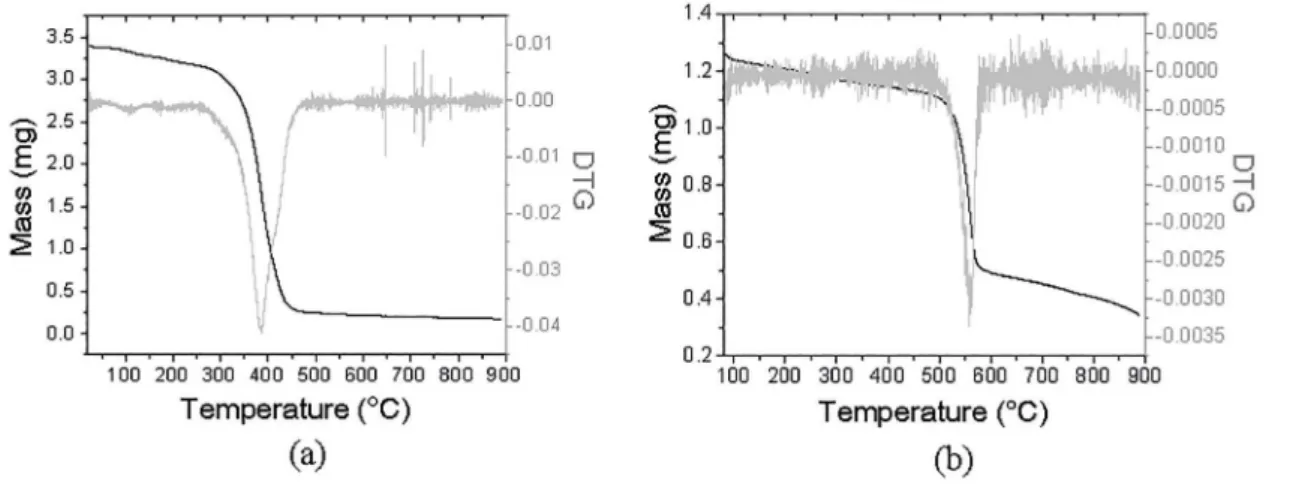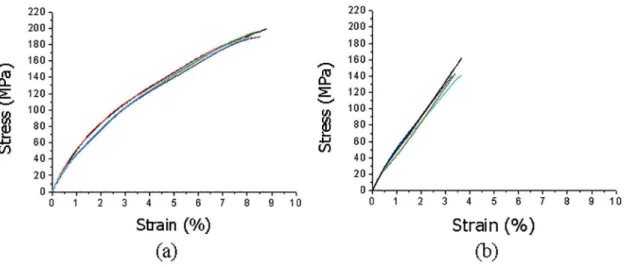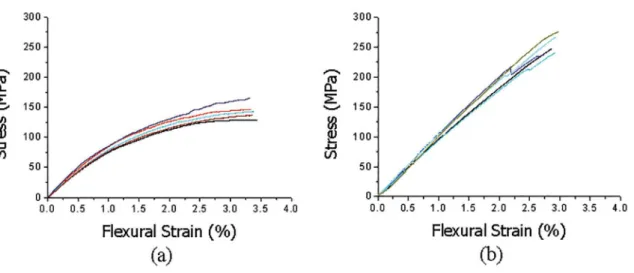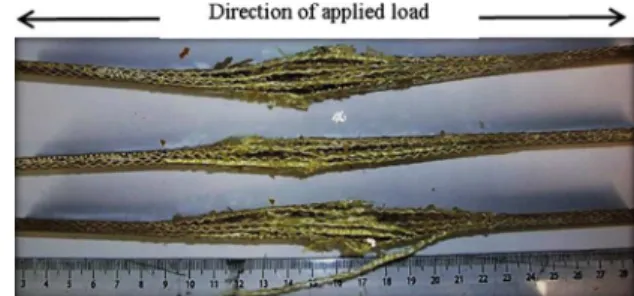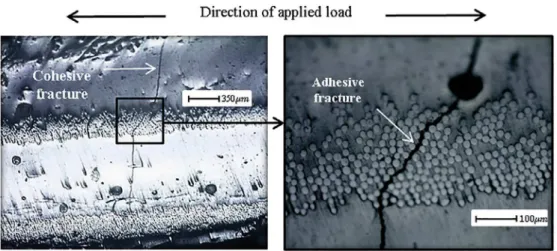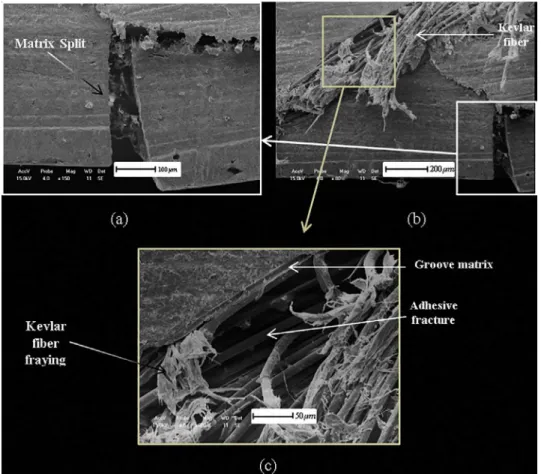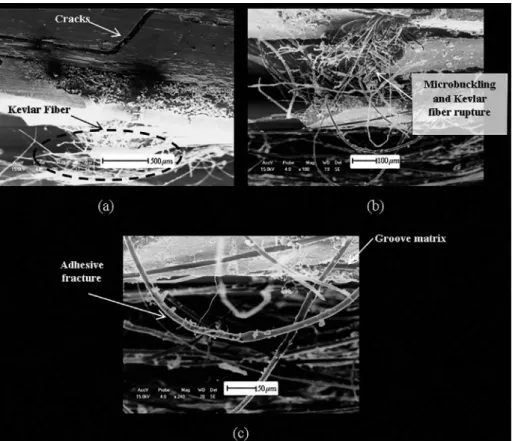Received: August 9, 2016; Revised: January 17, 2017; Accepted: February 12, 2017
In an efort to show the inluence of the hybridization method in hybrid fabric reinforced composites within the characteristic of the fracture and the mechanical properties, two laminate reinforced with bi-directional woven were developed, where one of them was reinforced with a hybrid strand (hybrid strand composite laminate) and the other with a diferent strands (hybrid fabric composite laminate). Both laminates used polyester resin, Kevlar-49 and glass-E ibers, had four layers and were prepared industrially by hand lay-up manufacturing. The percentages by weight of iberglass and Kevlar in each type of woven are equal. The hybrid strand composite laminate showed a higher tensile strength, however the hybrid fabric composite laminate showed superior properties in three-point bending test, for example, 41.7 % superiority in lexural strength. The results showed that the hybridization method in hybrid reinforced composites inluences the mechanical behavior of laminates and the formation and spread of damage.
Keywords: Polymer Composite, Hybridization, Fiber Characterization, Fracture Process
* e-mail: renata.felipe@ifrn.edu.br
1. Introduction
The increase of products using polymer composites reinforced with ibers is growing every day. They have been intensively used in all kinds of industries such as aerospace, shipbuilding, transport¹, as well as in sectors of printed circuit and hardware engineering, ballistic components, equipment and pollution control accessories, automotive parts, electrical components and rehabilitation products². Among its advantages, can be highlighted the high speciic strength and stifness, excellent corrosion resistance compared with the metal and its great anisotropy that depends on the type of array and provision of the reinforcing material and the type of coniguration³.
Among the polymeric materials reinforced with ibers, stand out the hybrid polymer composites that ofer advantages in the combination of ibers used as reinforcement, producing a material with higher speciic properties1,4-6, which would be
diicult to obtain using a single type of ibers reinforcement. The hybridization is increasing its use and various studies have been made, as can be seen in the work developed by Jung and Kim3, where they analyzed the inluence of the fracture toughness (using a fracture toughness test) on hybrid polymeric composites reinforced with carbon iber and glass. The test results showed that the iber arrangement inluence signiicantly the fracture toughness of the composite material; Zhang et al.7 studied the inluence of the coniguration using glass iber and carbon iber when subjected to tension, compression
and three-point-bending tests. The main results show that the hybrid laminates with 50% carbon iber reinforcement exhibit the best properties of three-point-bending, when the carbon layers are placed on the surface (outer layers), while the alternating coniguration carbon/glass provides greater resistance to compression. Zhang et al.7 concluded in his work that the tensile strength is insensitive to the sequence of coniguration (stacking sequence).
of the distribution of the layers) inluence the ballistic energy absorption.
The papers aforementioned sewed materials in which were used a hybridization with diferent layers (each fabric using one speciic iber), but other types of hybridizations are already been gaining space, as those using hybrid fabrics (in each layer, the fabric has strands with diferent ibers), for example, Valença et al.11 studied an comparative mechanical properties of a composite using solely Kevlar ibers as reinforcing and other two laminates using the hybrid composite of glass and Kevlar ibers; where in the composite hybrid structure of Kevlar/glass ibers showed the best results in terms of speciic strength as well as bending and impact energy.
The diferential of this paper concerns that the studies conducted until now, none deals with the hybridization method, that is, despite being used hybrid composites, they do not hold the fracture mechanism in the mechanical characterization of the material. Therefore, in this work it is developed two hybrid laminates, but one using a hybrid fabric formed by hybrid iber strands of Kevlar/49 and glass/E iber; and the other by a hybrid fabric with weft and warp formed of Kevlar/49 and glass/E ibers (strands of a single type of iber and distributed alternately), respectively.
The laminates were submitted to uniaxial tensile and three-point bending tests in order to obtain a characterization of the fracture mechanical properties. The study was performed by using the morphology of the fracture aiming to explain in fact the inluence of the hybridization method. Determination of properties, such as density and volumetric percentage of the constituent phases, has been performed for all the composites. In the latter case, the percentages are characterized by the pyrolysis test taking into consideration diferent types of ibers.
2. Materials and methods
2.1 Materials – Reinforcement and resin
To perform the study, two laminates were used, both hybrids and with four layers, which both using the thermosetting resin of ortho-terephthalic unsaturated polyester with technical speciication Novapol - L20, glass/E ibers and Kevlar/49 ibers; the diference between the laminates is given by the hybridization method of reinforcing fabric.
For matrix catalyzing, methyl-ethyl-ketone peroxide (MEKP) has been used in a proportion of 1 % of the resin volume, being the cure process of the composite laminates at room temperature. The resin has the following characteristics: Viscosity brook (SPD 2/60rpm) 250-350 cP; Density 1.23 g/cm³ at 25 °C; Gel time (1 % MEKP) 9-13 min at 25 °C; Exothermic peak of 150-190 °C; and acid value: maximum 30 mg KOH/g.
The hybrid fabric where each of the strands consists of glass/E iber and Kevlar/49 iber yarns is provided by TEXIGLASS Company and commercially known as KV-650. It has 63 % of Kevlar/49 ibers and 37 % of glass/E iber by weight, with grammage of 643 g/cm2 and it has 487 Kgf and 343 Kgf of the breaking load (theoretical) of warp and weft, respectively, according to manufacturer’s speciication.
The other hybrid fabric is manufactured on a manual loom by using the bidirectional woven glass/E iber, provided by the company TEXIGLASS, being commercially called WR-600/ 3-1 (with grammage of 610 g/cm2 and 185 Kgf and 120 Kgf of the breaking load (theoretical) of warp and weft, respectively, according to manufacturer’s speciication). For this purpose, iber glass strands were withdrawn from weft and warp alternately; and where their strands were removed, strands of Kevlar/49 ibers (with 18-24 Kgf of the breaking load theoretical, according to manufacturer’s speciication) were placed, taken from the bidirectional woven of Kevlar ibers, also provided by the company TEXIGLASS, with commercial designation KV 110/1-0. Reservation is made when in the replacement of strands for making the hybrid fabric, the percentages were maintained in weight of ibers (glass and Kevlar), thus giving an approximate inal weight of 630 g/m2 and substantially equal to the woven with hybrid strand. The average values and the standard deviation of the diameters of Kevlar ibers are (12.581 ± 0.478) µm and of glass ibers are (23.356 ± 1.896) µm. Both of the fabrics used are shown in Figure 1.
2.2 Manufacturing of composite laminates
The laminate composite formed from woven with hybrid strand, known as Kevlar/glass Hybrid Strand Composite Laminate (HSCL), has four layers in its coniguration, while the other laminate formed with hybrid fabric where each section composing the weft and warp are of glass/E iber and Kevlar/49 ibers, however distributed alternately, also has four layers in its coniguration. The laminate is called Kevlar/glass Hybrid Fabric Composite Laminate (HFCL). Manual lamination manufacturing process (hand lay-up) was used for manufacturing the laminates, this being done in the industry. Specimens were cut with a diamond-cutting disk, sanded, and polished, according to technical standard. It is necessary at least ive specimens per test condition12.
2.3 Density Testing
Figure 1. Hybrid fabrics used in the manufacture of laminates; (a) fabric of hybrid strand and (b) hybrid fabric.
of Sartoriun brand BP 210S model with 0.1 mg resolution and a maximum capacity of 210 g, for performing the test.
2.4 Thermogravimetry (TGA)
This technique was used aiming to measure changes (losses) of mass of each constituent of the sample (resin, Kevlar ibers) during the heating, then serving temperatures that occur these losses, as a reference to be used during the calcination process since it is working with two diferent types of reinforcements, besides the polyester matrix. The atmosphere in the equipment for performing the assay was nitrogen with a low rate of 40.0 ml/min and a heating rate of 20 °C/min. The temperature range used was from 75 °C to 890 °C. The equipment used was the TGA Q50, TA Instruments.
2.5 Calcinations Testing
This test was used to determine the volume fractions of reinforcement, resin and voids (it is emphasized that the samples used were the same density test). The procedure used was through the use of the oven mule Fornitec model - Ind e Com. Ltda., where the samples were placed in ceramic crucible and heated for a period of 4 h at diferent temperatures.
The irst heating temperature of the sample was the temperature relating to the resin, being the sample weighed after 4 h at this temperature; this weight was related to the volumetric fractions of Kevlar and glass ibers. Following, this material referring to the ibers was heated for 4 hours at a temperature related to the weight loss of Kevlar iber
and thereby leaving only the glass ibers. The residual mass of the glass ibers after the complete burning of the resin and Kevlar ibers was initial parameter for determining the contents of ibers, resin and voids, according to ASTM D 317114 standard.
2.6 Uniaxial tensile test
The uniaxial tensile test was performed according to ASTM D 303912 standard. Tests were performed for each type of composite laminate, being eight specimens fractured and ive values recorded (required by the standard) of the valid tests considered. Uniaxial tensile test was conducted in the Universal Mechanical Testing Machine (AGI-250 KN Shimadzu), with a loading speed of 1.0 mm/min, and the average ambient temperature during the tests was 25±2 °C. The dimensions of HFCL laminate specimens were (250x25x3.2) mm and the HSCL laminate were (250x25x4.15) mm, respectively for length, width and thickness. The dimensions have tolerances of ± 1 %. The gauge length of all test specimens was 127 mm.
2.7 Three-point bending test
The three-point bending test was performed according to ASTM D 79015 standard, being obtained for both laminates
and span of 68.8 mm. The dimensions correspond to length, width, and thickness, respectively. The specimens vary in size because the thickness of the laminates (HFCL and HSCL) are diferent. The average ambient temperature during the tests was 25±2 °C.
2.8 Analysis of fractures.
In order to analyze the real inluence of the hybridization method, there were not only analyzed the quantitative data of uniaxial tensile and three-point bending, but also there will be a qualitative analysis of mechanical fracture through the macroscopic and microscopic analysis.
Macroscopy was performed using the scanner HP Photosmart C4280, while in optical microscopy was used the microscope Olimpus MG. For the scanning electron microscopy (SEM), the microscope Shimadzu model Superscan SSX-550 it was used.
3. Results and discussion
3.1 Thermogravimetry (TGA)
The temperatures at which occur weight losses of the HSCL and HFCL constituent materials laminates can be veriied in Figures 2 (a) and (b).
The graph of thermogravimetry (mass as a function of temperature) at the ortho-terephthalic polyester resin is shown in Figure 2 (a), whose mass used was 3.393 mg, where there it is veriied a temperature range between 280 °C and 450 °C for this mass loss, the latter being used for the calcination test.
The Figure 2 (b) shows the TGA of Kevlar iber, being the mass value of the sample used for the test of 1.2650 mg, where may be observed mass loss temperature range between 480 °C and 580 °C, the latter being used as a temperature used in the calcining test. The TGA iberglass was no longer necessary, once it is the last component of the material.
In Figure 3 (a), it is possible to observe the TGA graph of the HSCL laminate being used to test a sample of 6.9964 mg. It is veriied two well-deined levels, where the irst is related to mass loss range of the resin (280 to 450) °C, and the second (450 to 580) °C corresponding to mass loss of Kevlar iber. In this way, we can conirm the weight loss temperature of the resin shown in Fig 2 (a). The same conclusion can be reached with respect to the second stage where the weight loss temperature of the Kevlar iber was 580 °C, also conirming the behavior shown in igure 2 (b).
In Figure 3 (b) is shown the graph related to TGA performed in the HFCL laminate, where was used a sample with mass of 6.4220 mg. Observed also two thresholds, being the irst well deined as the temperature at the mass loss of the resin and the second as the temperature at the Kevlar iber.
In light of the foregoing, the temperature that were determined in the TGA test served as the basis for carrying out the calcination assay for the determination of the resin, reinforcement and voids contents.
3.2 Calcinations testing
The values of the volumetric densities and volume fractions of reinforcement, resin and voids of HSCL and HFCL laminates are shown in Table 1.
According to Table 1, it is important to note that for the HSCL laminate, the resin content is less than the HFCL laminate, observed in microstructural characterization and during the process of manufacturing the same. This fact is explained once the fabric of hybrid strands has a weft and warp extremely closed, in other words, hindering the impregnation of the fabric by the resin during the manufacturing process. The hybrid fabric used to manufacture the HFCL laminate has features as the loose weft and warp, allowing passage of resin by respective interweaving, then occurring better impregnation of the fabric. This feature results in a lower percentage of voids in the composite laminate. This statement becomes more clearly after the analysis of the
Figure 3. Thermogravimetry test: (a) HSCL; (b) HFCL.
Table 1. Volumetric density and volume fraction of reinforcement, resin and voids.
Laminates Volumetric density (g/cm3) Glass Fiber-E (%) Kevlar Fiber (%) Matrix (%) Voids (%)
HSCL 1.45 ± 0.05 10.1 ± 1.0 45.4 ± 2.5 40.6 ± 3,5 3.9 ± 0.3
HFCL 1.55 ± 0.02 20.0 ± 2.0 31.0 ± 2.9 48.0 ± 2.5 1.0 ± 0.2
mechanical properties and fracture. It is emphasized here that the percentage of iberglass and Kevlar mass for each fabric type are equal.
3.3 Mechanical properties - uniaxial tensile
Mechanical behaviors related to uniaxial tensile tests of HSCL and HFCL laminates are irst evaluated from the stress-strain diagram, see Figure 4. It is highlighted here the diferent behavior of the laminates, noting that the HSCL laminate has a linearly elastic until the load at initial damage (approximately 40 % of tensile strength), while the HFCL laminate shows a linearly elastic behavior until the inal fracture of the material.
Figure 4. Stress x strain diagram (uniaxial tensile test): (a) HSCL; (b) HFCL.
Table 2 shows the results of the mechanical properties (average values) and standard deviation obtained for uniaxial tensile test of HSCL and HFCL laminates. With regard to the values of the modulus of elasticity, was calculated before starts load at initial damage, to avoid of the same inluence on the stifness of the material.
Batista et al.16 studied a hybrid composite with o plain bidirectional hybrid fabric, composed of E-glass iber and Kevlar/49 and as reinforcement and use epoxy vinyl ester thermosetting resin as matrix (Derakane 470-300) and in the uniaxial tensile test was obtained: (106.4±5.8) MPa for tensile strength and (3.9±0.3) GPa for elastic modulus.
Table 2. Mechanical properties - laminates HSCL and HFCL -
uniaxial tensile.
Mechanical Properties Composite
Laminate Tensile Strength (MPa) Elastic Modulus (GPa)
HSCL 193.04 ± 4.27 5.17 ± 0.34
HFCL 146.96 ± 8.96 5.27 ± 0.34
Almost no variation was observed in elasticity modulus of HSCL and HFCL laminates, whereas the HFCL laminate shows an increase in elastic modulus of about 2 % when compared to the HSCL laminate, so within the range of dispersion.
3.4 Mechanical properties – three-point bending
Figure 5 shows the performance of the mechanical properties obtained in the three-point bending test for both laminates, from the stress x lexural strain diagram. The HSCL laminate has a linearly elastic until the load at initial damage (approximately 40 % of tensile strength), while that the laminate HFCL presents a linearly elastic behavior until the inal fracture of the material.
Table 3 it is possible to observe the synthesis of the results of the mechanical properties (average values) determined at the three-point bending test as well as the values of the respective standard deviations. Batista et al.16 obtained to the hybrid fabric with glass/ Kevlar in the three-point bending test the values: (143.1 ± 7.9) MPa for lexural strength and (7.5 ±0.6) GPa for lexural modulus.
Was observed that generally the lexural properties of the HFCL laminate are superior when compared with the HSCL laminate properties, being strength and elasticity modulus the HFCL laminate superior in 41.7 % and 16.3 %, respectively.
Figure 5. Stress x Flexural Strain (three - point bending): (a) HSCL; (b) HFCL.
Table 3. Mechanical properties – laminates HSCL and HFCL –
three-point bending.
Mechanical Properties Composite Laminate Flexural Strength
(MPa) Flexural Modulus (GPa)
HSCL 147.90±15.89 8.24± 0.39
HFCL 253.87±16.97 9.85±0.51
3.5 Global comparative - the type Inluence
hybridization
In order to conclude the quantitative analyzes for hybridization, in Figure 6 is possible to observe a global view of the strength and stifness of tension and three-point bending test behavior for HSCL and HFCL laminates.
Thus, it is evident that the reinforcement fabric hybridization method inluences the mechanical behavior of laminates. In this way, the HSCL laminate, in terms of uniaxial tensile test, showed a superior strength and high deformation when compared to the HFCL laminate. However, when the laminates were submitted to three-point bending test, HFCL laminate showed superior properties. Tables 4 and 5 show the percentage of superiority in function of the type of load for each laminate.
In this sense, can say that the HSCL laminate showed in their behavior the prevalence of the properties of Kevlar iber, while the HFCL laminate shows a behavior characterized by the predominance of glass iber properties, which is in agreement with the results of calcining test since HSCL shows 45.4 % of Kevlar ibers while HFCL shows 31 % approximately.
Figure 6. Global comparison diagram - resistance and stifness.
Table 4. Inluence of hybridization method on laminate HSCL
specimens.
Mechanical properties Superiority (%)
Strength Tension > 30.5 % Flexion
Elastic Modulus Flexion > 59.4 % Tension
Table 5. Inluence of hybridization method on laminate HFCL
specimens.
Mechanical properties Superiority (%)
Strength HFCL: Flexion > 72.7 % Tension
Elastic Modulus HFCL: Flexion > 86.9 % Tension
Figura 7. Fracture characteristic - HFCL laminate - uniaxial tensile.
Figure 8. Fracture characteristic - HFCL laminate - uniaxial tensile.
Figure 9. Uniaxial tension - fracture characteristics - HSCL.
3.6 Characteristic of mechanical fracture -
uniaxial tensile
The characterization of the mechanical fracture starts with a macroscopic analysis of the same, noting that the HSCL laminate has a fracture of the DGM type (Edge delamination – Gage – Middle), see Figure 7, while the HFCL sufered the fracture LGM type (Lateral – Gage – Middle), see Figure 8, according to the ASTM D 303912 standard.
In Figure 7, it is possible to verify the delamination occurred in all layers of the laminate, concentrating on the central region of the specimen.
In is observed the iber pull-out in the fracture area after rupture and damage characteristic of polymer composites reinforced with fabric. It is important to remember that the characteristic of the inal fracture, when macroscopically analyzed, happened diferently of the HSCL laminate, which was characterized by delamination. It emphasizes that, for all HFCL laminates, there was not in fact the “total fracture” of the specimens tested, this fact made it diicult to micrographic analysis because there is no existence of a “inal section” of the fracture.
The microscopic study of the fracture, it begins with an analysis of optical microscopy and occurs in the fractured region (along the specimens thickness) of the HSCL laminate, as shown in Figure 9. The formation of cracks in matrix cross-section direction of applied load. In Figure 9, it can
be seen that the microcracks propagates in the direction of hybrid strand penetrating into the same. In their spread within the strand, the cracks starts to cause iber/matrix interface debonding, and this type of fracture is called “adhesive fracture.”
Proceeding the microscopic analysis of inal fracture in HSCL laminated, now using Scanning Electron Microscopy (SEM). In the Figure 10 (a) observed with more detail the crack in the matrix is propagated inside the strand causing the adhesive fractures (iber/matrix interface debonding) and the cohesive iber. However, when looking at Figure 10 (b), the presence of transverse cracks is observed to propagation in the matrix at the contour and inside the hybrid strand.
Already in Figure 10 (c) it can be seen that the microcrack propagation both the contour of the strand as well as in the warp, moreover, there is microbuckling and Kevlar iber rupture and adhesive fracture. Still analyzing the specimens surface of the HSCL laminate by SEM, there is cracks cross direction of loading and delamination, see Figure 11.
Figure 10. Fracture characteristics - HSCL laminate.
Figure 11. Fracture on the surface - HSCL laminate.
in Figure 12, it is possible to observe the propagation of a microcracks within the reinforcement layers in the cross-section of the inal fracture, originating cohesive fracture and adhesive fracture.
Continuing the analysis, by SEM, see Figure 13, observed adhesive and cohesive fractures, as well as Kevlar rupture iber. Observed that this type of damage tends to break along the iber, this characteristic being detected in Kevlar iber, as was also observed in HSCL laminate, as well as rupture and pull-out iber, see Figure 13 (a).
It can be observed in Figure 13 (b), the presence of a few pieces of matrix adhered to the ibers, the cohesive fracture and microbuckling in kevlar iber. Finishing the fracture
analysis for the HFCL laminate, shows iber bundle pull-out (adhesive fracture) and cohesive fracture in iberglass, see Figure 13 (c).
It is important to explain that the fabric hybridization process had inluenced the damage mechanism when analyzed in both levels (macroscopic as microscopic), once there was in the HSCL laminate a low resin impregnation in the reinforcing material because of the fabric characteristics, making diicult the resin passage between the reinforcement layers. However, in the HFCL laminate, since the strands were not hybrid and the fabric had a weft/warp less tight, in other words, greater lexibility, so facilitating the impregnation of the reinforcing material.
Another important factor is that the values of resin content conirm this theory, lack of impregnation of the reinforcing material since the resin percentage was higher in the HFCL laminate.
Observing Figure 14 you can see a comparative lowchart of the fracture for the response of both rolled under tensile loading.
3.7 Fracture of three-point bending test
Figura 12. Fracture characteristics – HSCL laminate.
Figure 13. Fracture characteristics – HFCL laminate.
Figure 15. Fracture characteristic – HSCL laminate – three-point bending.
Figure 16. Fracture characteristic – HFCL laminate – three-point
bending.
Figure 17. Fracture - HSCL laminate.
Analyzing the Figure 15, observed that there was no complete fracture of the test body resulting in a whitened area only in the inal fracture region, located in the cross-section of specimens. Regarding the analysis of HFCL laminated fracture, as seen in Figure 16, it is clear that the fact the specimens were broken by bending once tensile side there is the presence of points of cracking the matrix, being evidenced by the whitened region.
For the study conducted through the optical microscope, the HSCL laminate, and thickness of the specimens. In the tensioned layer, it is possible to observe some fracture characteristics such as the presence of cohesive fracture in the matrix, where the microcracks propagate around the weft (hybrid strand) fabric, so causing iber/matrix debonding (adhesive fracture), see Figure 17.
The Figure 18 shows details of the fracture mechanism from the analysis via scanning electron microscopy (SEM), where can be observed the crack formation in the tensile side with branch on contour of hybrid strand, and the location of this matrix split as a characteristic of good performance of the laminate against the bending load, as shown in Figure 18 (a). It is also seen the spread of same in the warp, causing fraying of Kevlar iber, being evidenced by the appearance of the Kevlar iber, as shown in Figure 18 (b). However, it also occurs a groove matrix formation caused by the lack of iber/matrix debonding interface and/or even by the ibers pull-out. Furthermore, it is also seen the adhesive fractures in the iber being evidenced by observing the iber surface, because it presents no residue of matrix, see Figure 18 (c). This same type of damage sufered in Kevlar ibers was also detected in the work developed by Alagar et al.2 e Nilakantan et al.17.
Regarding the analysis of the fracture from the optical microscope held at HFCL laminate, emphasize the fracture cohesive kind in the matrix (generation of the crack in the tensile side of the specimens), with the spread of it within the layer, causing the iber/matrix debonding, Figure 19.
Figure 18. Fracture - HSCL laminate
Figure 19. Fracture characteristic – HFCL laminate
should be noted, moreover, the occurrence of the rupture in Kevlar ibers. Now in Figure 20 (b) are evident phenomena of rupture and microbuckling of Kevlar ibers, since they appear frayed, one of the same fracture characteristic. In the Figure 20 (c), adhesive fracture and fraying is evident in the Kevlar ibers and also the ibers pull-out characterized by groove matrix formation.
The Figure 21 shows a comparative lowchart of the microscopic and macroscopic fracture characteristics in the HSCL and HFCL laminates bending under loading.
4. Conclusions
Given the above, it can be concluded that:
• Higher incidence in the number of manufacturing defects (microcracks and voids) in the HSCL laminate due to the hybrid fabric coniguration, so hindering the resin impregnation through the layers of reinforcements;
• As regards the percentages of the constituents (by volume), the laminate HSCL showed a lower percentage of resin and higher percentage of ibers and voids when compared to the HFCL laminate, this being expected since there was less impregnation of the fabric by matrix;
Figure 20. Fracture characteristics – HFCL laminate.
Figure 21. Flowchart: three-point bending test fracture characteristics.
initiation loads; and can be diferent depending upon the hybridization method;
• The HFCL laminate had a better three-point bending behavior when compared to the uniaxial tensile, showing that the hybridization method inluences the mechanical behavior of laminates;
• The inal macroscopic fractures of HSCL and HFCL laminates were the type DGM and LGM respectively according to ASTM D 3039 standard in the uniaxial tensile test;
1. Yahaya R, Sapuan SM, Jawaid M, Leman Z, Zainudin ES. Mechanical performance of Woven knaf-Kevlar hybrid composites. Journal of Reinforced Plastics and Composites. 2014;33(24):2242-2254.
2. Alagar M, Ashok Kumar A, Mahesh KPO, Dinakaran K. Studies on termal and morphological characteristics of E-glass/Kevlar 49 reinforced siliconized epoxy composites. European Polymer Journal. 2000;36(11):2449-2454.
3. Jung H, Kim Y. Mode I fracture toughness of carbon-glass/epoxy interply hybrid composites. Journal of Mechanical Science and Technology. 2015;29(5):1955-1962.
4. Wan YZ, Chen GC, Huang Y, Li QY, Zhou FG, Xin JY, et al. Characterization of three-dimensional braided carbon/Kevlar hybrid composites for orthopedic usage. Materials Science and Engineering: A. 2005;398(1-2):227-232.
5. Wan YZ, Lian JJ, Huang Y, Wang YL, Chen GC. Two-step surface treatment of 3D braided carbon/Kevlar hybrid fabric and inluence on mechanical performance of its composites. Materials Science and Engineering: A. 2006;429(1-2):304-311.
6. Naik NK, Veerraju C, Venkateswara RK. Hybrid composites under high strain rate compressive loading. Materials Science and Engineering: A. 2008;498(1-2):87-99.
7. Zhang J, Chaisombat K, Shuai H, Wang CH. Hybrid composite laminates reinforced with glass/carbon woven fabrics for lightweight load bearing structures. Materials & Design (1980-2015). 2012;36:75-80.
8. Dong C, Ranaweera-Jayawaedena HA, Davies IJ. Flexural properties of hybrid composites reinforced by S-2 glass
11. Valença SL, Griza S, Oliveira VG, Sussuchi EM, Cunha FGC. Evaluation of the mechanical behavior of epoxy composite reinforced with plain Kevlar plain fabric and glass/Kevlar hybrid fabric. Composites Part B: Engineering. 2015;70:1-8.
12. ASTM International. ASTM D3039. Standard Test Method for Tensile Properties of Polymer Matrix Composite Materials. West Conshohocken: ASTM International; 2008.
13. ASTM International. ASTM D792.Standard Test Method for Density and Specific Gravity (Relative Density) of Plastics by Displacement. West Conshohocken: ASTM International; 2008.
14. ASTM International. ASTM D 3171. Standard Test Method for Constituent Content of Composite Materials. West Conshohocken: ASTM International; 2004.
15. ASTM International. ASTM D790. Standard Test Method for Flexural Proprieties of Unreinforced and Reinforced and Electrical Insulating Materials. West Conshohocken: ASTM International; 2010.
16. Batista ACMC, Oliveira JFS, Aquino EMF. Structural degradation and mechanical fracture of hybrid fabric reinforced composites. Polymer Engineering & Science. 2016;56(6):657-668. 17. Nilakantan G, Obaid AA, Keefe M, Gillespie JWJ. Experimental

